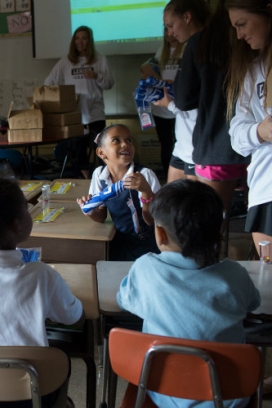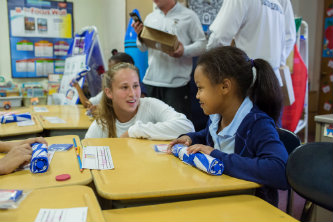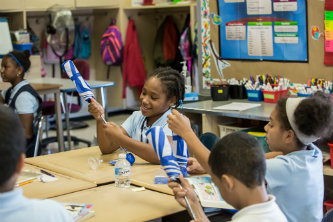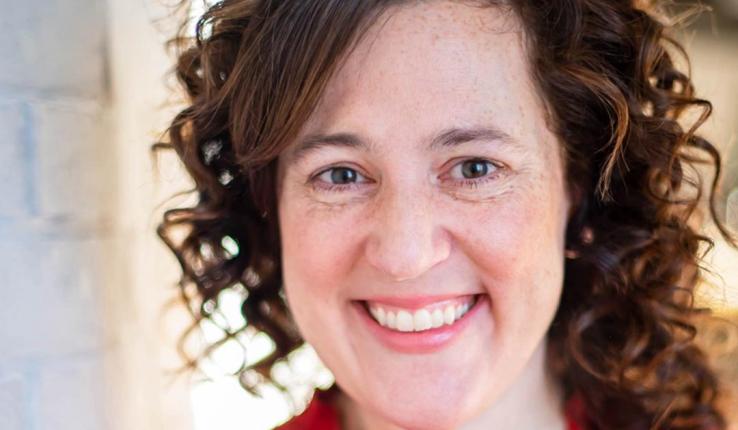Umbrellas, Community Outreach and Measurable Outcomes: Lehigh Students Assist McKinley Elementary with a Practical Approach to Absenteeism
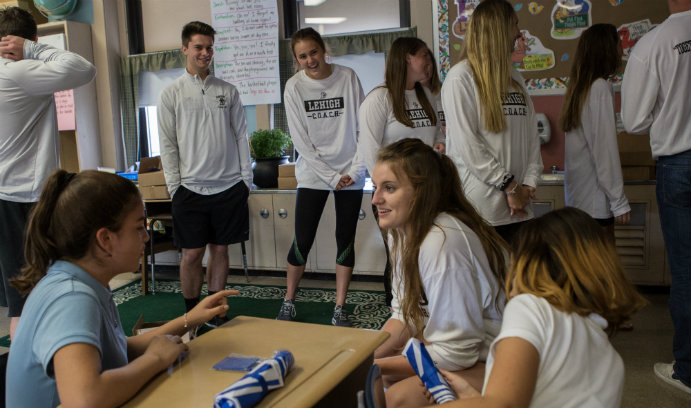
Scholar athletes from Lehigh's C.O.A.C.H. program delivered 300 umbrellas to McKinley Elementary School in Allentown to help students stay dry when walking to school on rainy days. Lehigh doctoral student and principal of the school, Scott Cole, thinks the umbrellas might help increase attendance on those days.
The students of McKinley Elementary walk to school every day. They walk under sunny and cloudy skies, through warm breezes and bitter windchills, in light drizzle and heavy rainfall. The small, urban school in Allentown with a population of approximately 300 first- through fifth graders places “consistently in the top two and three in all the major metrics of the highest poverty levels,” says the school’s principal, Scott Cole. Last year, 99.7 percent of McKinley students were eligible for free and reduced lunch.
“We are a community school,” says Cole, a doctoral student in educational leadership in Lehigh’s College of Education. “And we are very much the heart of this neighborhood. … Our families really do look to the school to kind of be their first stop when they struggle with things.”
One of the things many McKinley students struggle with is school attendance. Last year, Cole says, 13 percent of students were chronically absent, meaning they missed 18 or more days of school. Another 25 percent were at-risk of being chronically absent.
“When you combine those, that’s significant,” says Cole. “Almost 40 percent of our students are missing [school].”
Cole was in Craig Hochbein’s Evidence-Based School Improvement class this past summer when a discussion about shortfalls in the system of marrying research to practice turned to student attendance interventions.
Hochbein, an assistant professor of educational leadership, cited a recent study that linked bus transportation to reduced absenteeism among kindergarteners. He challenged the class to apply evidence from the study to develop a solution that improves student attendance at McKinley.
For a school in which every student walks, he asked, is there an analogous solution that’s within the grasp of a principal? In addition, how would we know if it was working?
Most McKinley families don’t own cars. Many older students are responsible for getting ready and walking to school on their own. Parents with babies might not want to take them out in adverse weather conditions to walk older children to school. The weather, Cole says, is often a factor: “Anecdotally, I can tell you that on rainy days [students] miss more [school]. If it’s raining outside, they don’t want to come.”
Cole recalls, “...We said, ‘What about just a simple nuts-and-bolts solution? What if we gave our kids umbrellas?’”
Engaging Scholar Athletes in Community Outreach
Neiad Ammary, also a doctoral student in educational leadership and a student in Hochbein’s course, knew where Cole might get those umbrellas: Lehigh Athletics. His wife, Julie, is Lehigh’s director of athletics leadership development, and his father-in-law, Joe Sterrett, is Lehigh’s Murray H. Goodman Dean of Athletics. Ammary, a 12th grade English teacher and boys’ volleyball coach at Liberty High School in Bethlehem, has also coached volleyball at Lehigh and was well aware of the athletic department’s various community outreach efforts.
He reached out to Roseann Corsi, director of public relations and alumni relations for Lehigh Athletics, and explained how they might be able to help. Immediately on board, Corsi brought the idea to Lehigh’s C.O.A.C.H. (Community Outreach by Athletes who Care about Helping) committee, a group of 24 scholar athletes who organize and run a variety of local community outreach initiatives.
“They all jumped on it like I did,” Corsi says. “When there’s a need out there, that’s our mission. We love to help others.”
C.O.A.C.H. holds fundraisers throughout the academic year to raise money for their community outreach initiatives. Local restaurants host events from which C.O.A.C.H. receives a portion of the proceeds. Student-athletes solicit donations from family and friends, and they collect money and spread awareness about their work at Lehigh football games.
“We really try to engage the entire athletic community as a whole and the entire campus community for that matter,” says Chris Kersey ’18, who studies finance and industrial systems engineering in the IBE honors program and is a member of the baseball team. “What we focus on is helping our surrounding community and the schools in our area, with not just a focus on the community itself, but a focus on helping kids.”
The program’s largest event—now in its 19th year—is its annual Adopt-a-Family program, through which various athletic teams, fraternities, sororities and university departments raise money and “adopt” a local family for whom they purchase gifts during the holiday season. When other opportunities for community outreach arise, C.O.A.C.H. helps whenever possible.
“This umbrella initiative definitely aligns with our mission and our goals,” says Kersey.
After consulting with Cole about McKinley’s needs, the C.O.A.C.H. program purchased 300 blue and white umbrellas (as close to the school’s official colors of blue and red as they could find) and delivered them to McKinley on Friday, Sept. 29. Moving from room to room, the Lehigh scholar athletes introduced themselves and talked about how they didn’t like getting wet on the way to class, either.
“We thought we’d help you out,” Kersey said with a smile as the group handed an umbrella to each student.
“I think it’s really awesome to be able to be involved in the community in a way that seems small but has a much bigger impact,” says Julia Washburn ’18, who studies political science and plays field hockey. “This is different from what we've done before. It’s great to engage with a new school in a new way.”
“We were just sitting in class, spitballing ideas,” says Cole of start of the umbrella initiative, “and it came to fruition. Lehigh’s been wonderful.”
Measurable Outcomes for Reducing Absenteeism
The umbrellas will serve a purpose beyond the obvious benefit of keeping students dry on their way to school. Cole plans to study whether the umbrellas have an impact on student attendance and is determining his approach now.
“I want to compare both the average daily attendance for the whole student group and the at-risk kids, and I want to look at some other factors [as well]: when it was raining, the temperature when it was raining. A drizzle at arrival time in 80 degrees is a whole different ball game than rain at arrival time at 50 degrees. So I want to track if there’s any kind of difference there,” he says.
He’ll use the National Oceanic and Atmospheric Administration (NOAA) database to identify past rainy days and compare them to the school’s average daily attendance history and continue that comparison moving forward for “a rough overall view of what our average daily attendance looks like on a rainy day, pre-umbrella versus post-umbrella.”
Cole also plans to examine closely the attendance of the students who have been enrolled at the school consistently and are chronically absent or have at-risk attendance.
“Kids with at-risk or chronic absenteeism tend to be our kids that are more transient,” he says. “But I know that we have a core group of those kids that have been with us for three, four, sometimes five years. So we can track those kids. I want to see if there’s impact on those kids versus the regular, all-student populations—if the umbrellas have less of an effect or more of an effect on those kids.”
In an effort to determine the sustainability of the umbrella initiative, Cole also plans to track the distribution of multiple umbrellas to get a sense of any loss rate.
“If we’re seeing some impact, [this will help us] come up with an estimated sustainability cost. We are very fortunate as a community school in that we have access to a lot of community partners who might be able to foot some of that expense if it’s a feasible amount,” he says.
Umbrellas, of course, aren’t the answer to all of the obstacles McKinley’s students face—some are far too complicated. For those problems, says Cole, the school has larger-scale, comprehensive interventions in place. But for children who walk to school alone and decide to stay home because they don’t want to get wet, an umbrella might improve access to those interventions.
“I’m excited to see and to track what it’s going to look like,” says Cole. “I’m really optimistic that it’s going to make a difference for our kids, which is really what the bottom line is. So many of our kids have so many obstacles towards them coming to school, engaging in school in a meaningful way. If we can remove one of those by something as simple as giving them an umbrella, why not?”
Photos by Christa Neu
Posted on:


